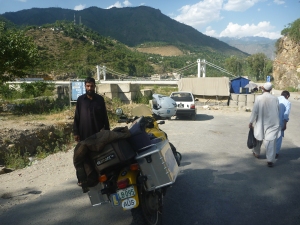
Picture postcard perfect – near Shinkiari. The scenery and the roads were about to change very dramatically
Having spent a lazy three days in Abbottabad, feeling relaxed and refreshed, I bade farewell to Ahmed and his family’s hospitality and pointed the bike north. The goal for today was the little town of Besham – a short trip of only about 150km.
As the goal was modest I got away mid-morning… ish!
At one stage I had considered taking the road up the scenic Kaghan Valley to Naran – a popular place to escape the heat of the Punjabi plains. This road also leads on to the Babusar Pass (4200m) and Chilas, further along the KKH. The route was not only much cooler and more picturesque but also had the potential to save a couple of hundred kilometres. There was only one small hurdle. Even though it was now early/mid June and well into the summer, the Babusar Pass was reportedly still covered by 2-3m of snow and would not be open for at least another 1-2 weeks – too late to be of any benefit to me. So when I couldn’t find the turn-off to Naran in the midst of the mayhem of Mansehra I continued straight ahead up the KKH and on towards Besham.
In Besham, I was planning to stay at the local PTDC. The Pakistan Tourist Development Corporation operates a series of hotels and guesthouses of varying standards across the country. They are mostly used by government officials who have to travel around Pakistan. However, they are open to the public if there are rooms available.
The road north through Mansehra, Shinkiari and Batagram was in good condition with relatively little traffic and made for pleasant and hassle-free riding.
That was all about to come to a sudden halt.
About 20km short of Besham, the KKH crosses the Indus River at the Thakot Bridge. The bridge also marks the boundary between the relatively modern district of Mansehra and the “not-so-modern” district of Kohistan. Before the bridge, I was stopped at a police checkpoint and was required to register my passport details in a tired, old, dog-eared book. When I asked the friendly police officer if I could take a photo of the bridge he told that it was not allowed because it was “high security”. So I asked him if I could take a photo of him – to which he promptly agreed! Unfortunately, I couldn’t get a better shot of the original suspension bridge.
As soon as I crossed the bridge into Kohistan district, it was was like stepping back 100 years in time. Where the KKH had been a passable two-lane road, comparable to the Bruce Highway of the ’60s, it gradually deteriorated to a gravelly, rubbly track. As well as that, Kohistan has additional travel restrictions where all foreign tourists have to have a police escort between villages. I was relieved that I only had about 20km to go to Besham and my bed at the PTDC.
The PTDC at Besham was a clean but rather characterless place. A moderately large facility, it was virtually deserted apart from a team of Chinese road engineers and their local workers. It was obviously a long time since any western tourist had stayed there. The staff initially seemed to have forgotten what a tourist was but eventually became open and friendly – like everybody else I had met in Pakistan.
The next day’s ride was originally going to be to Shatial – about 125km away. Based on today’s experience I scaled that back to the next PTDC at Dasu which was only about 85km away. Much less demanding.
Those plans were about to go out the window as well!


